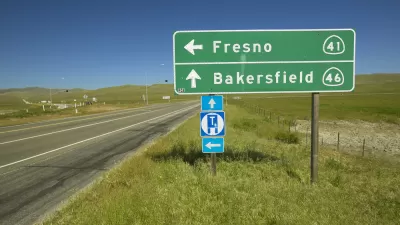The New York Times, San Francisco Chronicle, and Sacramento Bee editorialize on the signing of SB 375, California's new landmark law that is intended to reduce greenhouse gas emissions by reducing vehicle miles traveled through better land use.
From the New York Times:
"For years, while Washington slept, most of the serious work on climate change has occurred in the states, and no state has worked harder than California. The latest example of California's originality is a new law - the nation's first - intended to reduce greenhouse gas emissions by curbing urban sprawl and cutting back the time people have to spend in their automobiles."
"The bill contains significant incentives, including the promise of substantial federal and state money to regions whose plans pass muster. In addition, and with the consent of the environmental community, the state will relax various environmental rules to allow "infill" - higher-density land use in or near cities and towns.
Given California's size, these and other initiatives will help reduce global greenhouse gas emissions."
From the San Francisco Chronicle:
"It's a novel answer in many ways. While California has churned out rules for high-mileage vehicles, solar panels, clean-burning fuel, and efficient energy use, it's overlooked the everyday problem of long commute times from distant suburbs in carbon dioxide-spewing cars and trucks."
"The bill may take years to show its effects. As new homes and apartments go up, there could be a break from California-style sprawl as construction fills in city lots and residents see the opportunities close to city centers. On the atmospheric scale, some 30 percent of the greenhouse gas emissions presently come from cars and trucks, a figure that could gradually drop as driving patterns shift from distant suburbs to shorter routes closer to work."
From the Sacramento Bee:
"More than any previous law, Steinberg's seeks to address one of California's nagging flaws – its Wild West patterns of development. Housing separated from jobs has led to traffic jams, smog, long-distance commutes, loss of valuable farmland and transit systems that can't easily build ridership.
SB 375, by itself, won't stop this kind of "dumb growth." But it will discourage it – and help create more sustainable communities – with a mix of incentives and regulatory relief."
Thanks to Virginia Harris
FULL STORY: Editorial: Cut the Sprawl, Cut the Warming

Depopulation Patterns Get Weird
A recent ranking of “declining” cities heavily features some of the most expensive cities in the country — including New York City and a half-dozen in the San Francisco Bay Area.

California Exodus: Population Drops Below 39 Million
Never mind the 40 million that demographers predicted the Golden State would reach by 2018. The state's population dipped below 39 million to 38.965 million last July, according to Census data released in March, the lowest since 2015.

Chicago to Turn High-Rise Offices into Housing
Four commercial buildings in the Chicago Loop have been approved for redevelopment into housing in a bid to revitalize the city’s downtown post-pandemic.

New Park Opens in the Santa Clarita Valley
The City of Santa Clarita just celebrated the grand opening of its 38th park, the 10.5-acre Skyline Ranch Park.

U.S. Supreme Court: California's Impact Fees May Violate Takings Clause
A California property owner took El Dorado County to state court after paying a traffic impact fee he felt was exorbitant. He lost in trial court, appellate court, and the California Supreme Court denied review. Then the U.S. Supreme Court acted.

How Urban Form Impacts Housing Affordability
The way we design cities affects housing costs differently than you might think.
City of Costa Mesa
Licking County
Barrett Planning Group LLC
HUD's Office of Policy Development and Research
Mpact Transit + Community
HUD's Office of Policy Development and Research
City of Universal City TX
ULI Northwest Arkansas
Town of Zionsville
Urban Design for Planners 1: Software Tools
This six-course series explores essential urban design concepts using open source software and equips planners with the tools they need to participate fully in the urban design process.
Planning for Universal Design
Learn the tools for implementing Universal Design in planning regulations.




















